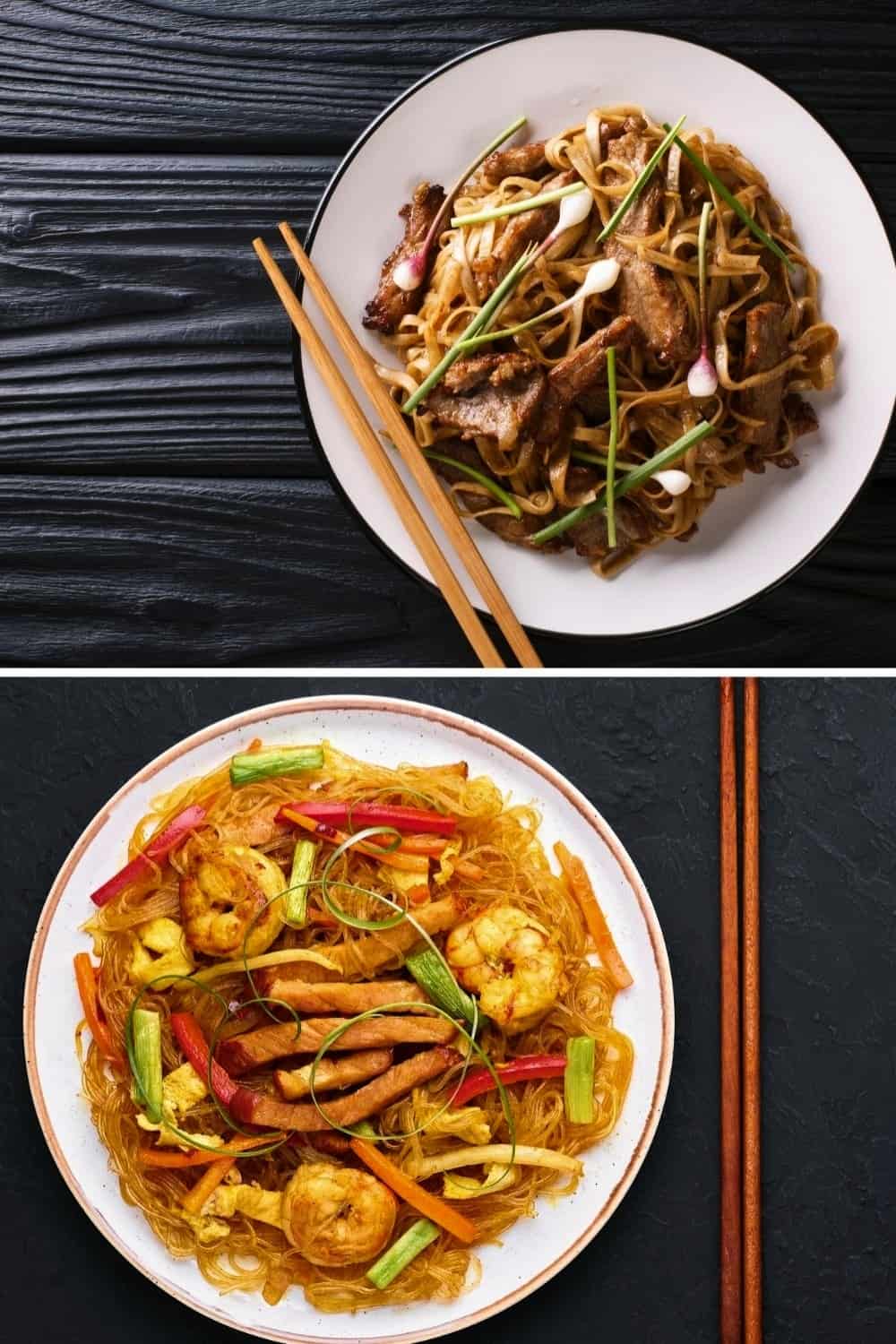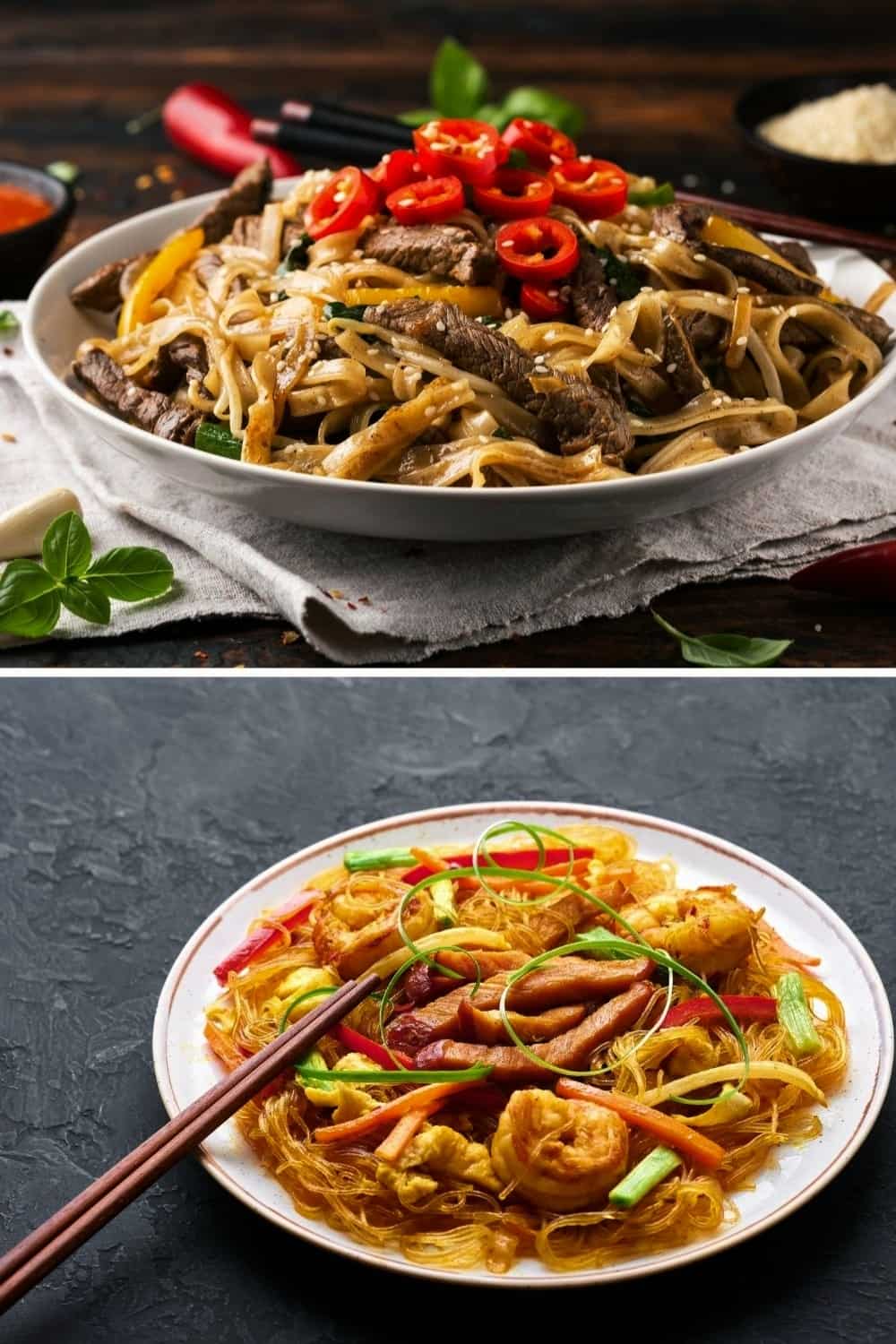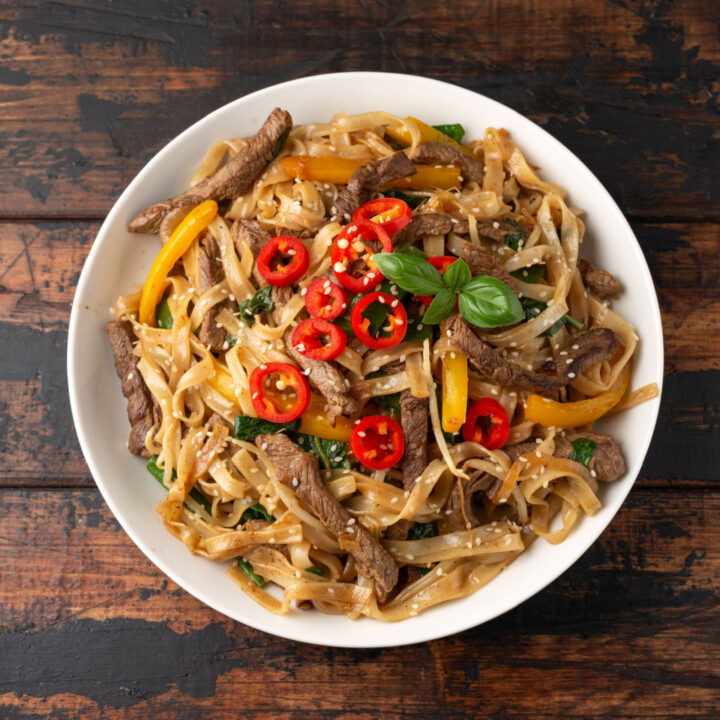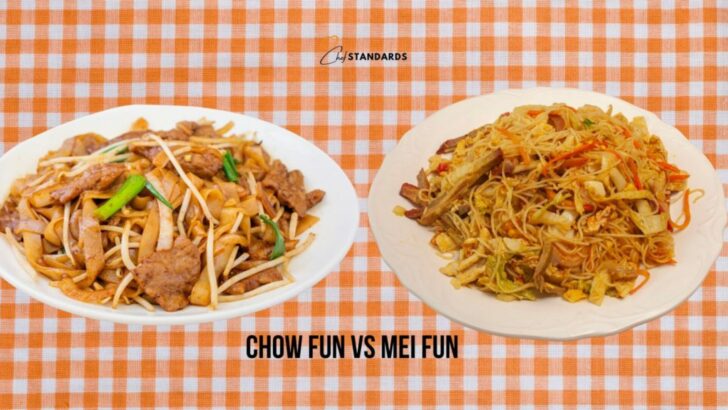When you think about Asian cuisine, you will realize that there are many dishes that incorporate noodles.
I mostly heard about Chow Mein, but I was surprised when I discovered many other noodle dishes that are also very delicious and nutritious.
Chow fun and mei fun both have these characteristics. These two types of noodles/noodle dishes have so much in common, but they are still two different things.
Appearance, flavor, and ingredients are one of the most important differences between these two and it is essential to get to know them.
[table id=64 /]
Chow Fun Vs Mei Fun: Basics

Before I head to the main differences between chow fun and mei fun, I will briefly explain the most important facts about these two Chinese classics.
Chow Fun
It is a wide rice noodle (an inch wide or more, depending on the type) with a yellowish color and its origin can be traced back to southern China, particularly to the Cantonese region. It is also known as “hor fun” or “shahe fen”.
Chow fun actually translates to “stir-fried noodles” in English, which says a lot about them.
As you can easily conclude from the name itself, they are mostly stir-fried, but they are not limited to that cooking method only, as you can also incorporate chow-fun noodles into soups. Some noodles can even be used as a side for sandwiches.
I have to say that the term “chow fun” is not only reserved for the noodles themselves, but also for the dishes that incorporate those noodles, alongside other ingredients like protein, vegetables, and sauces.
Two main types are the wet and dry varieties. The popular name for wet chow fun is Hong Kong-style chow fun, and this type is often slightly sweeter with a more complex flavor profile.
However, dry chow fun is the most common method for chow fun nowadays, although it is a little less flavorful when compared with the wet version.
I also have good news for those with gluten intolerance, since chow fun noodles are gluten-free and are actually one of the most popular gluten-free Chinese foods.
Mei Fun
Mei fun noodles are vermicelli-like rice noodles that are pretty thin and delicate, especially when compared with chow fun, and they are somewhat white in color.
When someone speaks about mei fun, you will also hear the terms “main fun” or “mee fun”. The exact origin of mei fun is not as well-documented as some other Chinese dishes.
However, like many other Chinese noodle dishes, it is believed to have originated in southern China, particularly in the region of Guangdong province, where Cantonese cuisine is prominent.
Like with chow fun, the term “mei fun” is not only for the noodles but also for the dishes that incorporate them.
Mei fun noodles are very versatile, as you can use them in soups and salads, aside from stir-fries.
Different versions of mei fun include traditional mei fun, Singapore noodle, and various local styles.
These types of noodles are always dry. However, just like chow fun, since they are made from rice, mei fun noodles are also gluten-free.
Although I am a big fan of Japanese noodle dishes known as Tan Tan noodles, the delicate and mild flavor profile of mei fun always delights my taste buds.
Chow Fun Vs Mei Fun: 5 Key Differences

Now that you know the basics, it will be easier to understand the key differences between these two popular types of Chinese noodles/noodle dishes.
1. Noodles
From the text above, you already know that chow fun and mei fun noodles alone are different types of rice noodles. However, this is especially important to know when incorporating them into specific types of dishes.
For example, if you are making dishes with all the same ingredients except for the noodles, those dishes will bear different names, and that is the case with both these two types of noodles from China.
Now, chow fun showcases wide, flat rice noodles, which are substantial and chewy, creating a satisfying mouthfeel with each bite.
The difference lies in the fact that these noodles are robust enough to absorb the savory flavors of the meat, veggies, and sauces, making chow fun a hearty and filling dish.
On the other hand, mei fun takes a more delicate approach with its thin rice vermicelli noodles.
These fine noodles have a soft and tender texture, allowing them to soak up the lighter seasoning and vegetable flavors without overpowering the dish.
2. Flavor Profile
The flavor of chow fun and mei fun noodles alone is quite similar since both types of noodles are made from rice. The only real difference is that mei fun noodles are slightly more delicate.
When it comes to the dishes where these noodles are used, the exact flavor profile mainly depends on the ingredients used, so it is quite difficult to say.
However, there are a few standards when it comes to some ingredients. Dark soy sauce and oyster sauce are heartier sauces and they are used in this one.
This makes chow fun bolder and savory in flavor. On top of that, the stir-frying process at high heat infuses the dish with a rich umami taste, complementing the substantial rice noodles and protein components.
Mei fun has a more subtle and delicate flavor profile because it uses lighter seasonings, particularly light soy sauce. Oyster sauce can also be used, but it pairs better with chow fun.
These lighter seasonings allow the natural flavors of the rice vermicelli and fresh vegetables to shine through.
See Also: Pad See Ew Vs Pad Thai: The Clash In The Thai Kitchen
3. Ingredients
Aside from noodles and sauce, you can also use some type of protein and various veggies.
However, there are some unwritten rules worth keeping in mind. Starting with chow fun, you will mostly use heartier meats, such as beef and pork, but it is not forbidden to use chicken or seafood like shrimp as well.
Know that, if you choose to incorporate shrimp, white spots on shrimp are not a sign of spoilage, and that they can still be eaten safely.
However, those heartier meats stand up well to the robust flavors of the wide rice noodles and savory sauces, so they are more suitable.
Mei fun, with its lighter profile, often incorporates leaner meats like chicken and shrimp, allowing the delicate rice vermicelli and vegetables to take center stage.
Additionally, various types of vegetables can enrich mei fun, and some of those veggies include bean sprouts, carrots, scallions, and occasionally cabbage or bok choy, further enhancing the dish’s visual appeal and subtle flavors.
4. Cooking Techniques
The most important fact about these noodles when considering cooking techniques is their texture and size.
Since chow fun uses noodles that are thicker and more substantial, they can withstand higher heat and longer cooking times without becoming overly soft or mushy.
The cooking technique involves high-heat stir-frying in a hot wok. The high heat allows for the characteristic “wok hei” flavor, creating a slightly smoky and charred taste that adds depth to the dish.
The thick and sturdy Chow Fun noodles can handle the intense heat and being tossed around in the wok without breaking apart.
The high surface area and depth make the wok ideal for preparing wide flat noodles known as chow fun.
They have ample space to spread out and cook evenly, and the high walls of the wok prevent ingredients from spilling over during the vigorous tossing required for stir-frying.
Mei fun noodles are much thinner, so they cook much faster as well. It is therefore important to make sure not to overcook them by exposing them to high heat for an extended period of time.
By doing this, you ensure that the noodles remain intact and do not become too soft or clump together. If cooked for too long, they can even become mushy.
Mei fun noodles also require a wok for cooking but with a more shallow profile. A shallow wok ensures that the heat distributes evenly, preventing the noodles from sticking together and facilitating quick cooking.
5. Nutrition
The nutrition profile of both types of dishes mainly depends on the exact ingredients incorporated in the dish and they are quite similar.
However, there are some slight differences. Since chow fun incorporates thicker noodles, the carbohydrate content is slightly higher, providing more energy per serving.
Aside from that, traditionally, there are heartier ingredients in chow fun, and this contributes to a slightly higher caloric content per serving compared to mei fun.
The amount of protein mainly depends on the ingredients, but in general, they are very similar. I also have to emphasize that, if you are vegan, you can also use some other type of protein, like tofu or eggs.
In that case, the amount of protein will be much lower than when using meat.
The fat content is relatively low in both types of dishes. However, since there is a higher chance that you will use fattier meat in chow fun, it might contain a higher amount of fat in some cases.
Finally, the amount of vitamins, minerals, and dietary fiber completely depends on the various vegetables used in a dish.
I also have to emphasize that these noodles are completely vegan-friendly, unlike some other types of noodles. For example, that is one of the main differences between egg noodles and rice noodles.

Chow Fun Recipe
Let me show you one of the most popular chow fun recipes. It is a Cantonese beef chow fun recipe that will alarm your savory cravings at the highest level.
Ingredients
- 8 ounces (225g) wide rice noodles (Chow Fun noodles)
- 8 ounces (225g) beef (flank steak or sirloin), thinly sliced against the grain
- 2 tablespoons vegetable oil
- 3 cloves garlic, minced
- 1-inch piece of ginger, minced
- 1 cup bean sprouts
- 2 stalks scallions (green onions), sliced diagonally
- 1 tablespoon soy sauce
- 1 tablespoon oyster sauce
- 1/2 teaspoon sesame oil
- Salt and pepper to taste
Instructions
• Soak the wide rice noodles in warm water for about 30 minutes until they are soft and pliable. Drain the noodles and set them aside.
• In a bowl, combine the thinly sliced beef with soy sauce, oyster sauce, and a pinch of salt and pepper. Mix well and let it marinate for 15-20 minutes.
• Heat 1 tablespoon of vegetable oil in a wok over high heat. Add the minced garlic and ginger, and stir-fry for a few seconds until fragrant.
• Add the marinated beef to the wok and stir-fry until it is cooked to your desired level. Once it is done, transfer it to a plate.
• In the same wok, add another tablespoon of vegetable oil over high heat. Add the soaked and drained rice noodles to the wok and stir-fry for a few minutes until they are heated through and slightly charred.
• Push the noodles to the sides of the wok, creating an empty space in the center. Crack an egg into the center and scramble it quickly.
• Add the bean sprouts and sliced scallions to the wok, and stir-fry for a couple of minutes until the vegetables are slightly softened.
• Return the cooked beef to the wok with the noodles and vegetables. Mix everything together until well combined.
• Drizzle sesame oil over the chow fun and give it a final toss to evenly distribute the flavors.
• Transfer the Cantonese Beef Chow Fun to a plate and serve hot. Enjoy your delicious homemade Cantonese Beef Chow Fun!
Notes
Feel free to experiment with this recipe by adding other veggies or seasonings according to your preferences.
You can also use chicken, pork, shrimp, or tofu instead of beef for different variations of this classic Cantonese noodle dish.
Nutrition Information:
Yield: 3 Serving Size: 1Amount Per Serving: Calories: 619Total Fat: 11gSaturated Fat: 1gTrans Fat: 0gUnsaturated Fat: 9gCholesterol: 0mgSodium: 650mgCarbohydrates: 118gFiber: 6gSugar: 2gProtein: 10g
Also, check out this video:

Mei Fun Recipe
Just like chow fun, I also decided to cover up one popular mei fun recipe, a well-known Singapore mei fun dish. Here is what you need to do.
Ingredients
- 8 ounces (225g) rice vermicelli noodles (Mei Fun noodles)
- 8 ounces (225g) shrimp, peeled and deveined
- 2 tablespoons vegetable oil
- 2 cloves garlic, minced
- 1 small onion, thinly sliced
- 1 red bell pepper, thinly sliced
- 1 carrot, julienned
- 1 cup bean sprouts
- 2 eggs, lightly beaten
- 2 tablespoons curry powder (preferably Singaporean or Malaysian curry powder)
- 1 tablespoon soy sauce
- 1 tablespoon oyster sauce
- 1 tablespoon fish sauce (optional, for extra umami)
- Salt and pepper to taste
- Fresh cilantro or scallions for garnish (optional)
Instructions
• Soak the rice vermicelli noodles in warm water for about 10 minutes until they are soft. Drain the noodles and set them aside.
• In a wok or large skillet, heat 1 tablespoon of vegetable oil over medium-high heat. Add the minced garlic and sauté for a few seconds until fragrant.
• Add the shrimp to the wok and stir-fry until they turn pink and are fully cooked. Remove the cooked shrimp from the wok and set it aside.
• In the same wok, add another tablespoon of vegetable oil over medium-high heat. Add the sliced onion, bell pepper, and julienned carrot. Stir-fry the vegetables until they are slightly softened.
• Push the vegetables to one side of the wok, creating an empty space in the center. Pour the beaten eggs into the center and scramble them quickly until cooked.
• Mix the scrambled eggs with the vegetables. Add the curry powder to the wok and stir-fry everything together for a minute until you can smell the curry powder.
• Add the soaked rice vermicelli noodles to the wok. Toss the noodles with the vegetables and eggs until they are well-coated with the curry powder.
• Pour the soy sauce, oyster sauce, and fish sauce (if using) over the noodles and shrimp. Stir-fry everything together until the seasonings are evenly distributed.
• Taste your Singapore Mei Fun and adjust the seasoning with salt and pepper, as needed.
• If desired, garnish the dish with fresh cilantro or sliced scallions for added flavor and presentation.
• Transfer the Singapore Mei Fun to a serving plate and serve hot. Enjoy your flavorful and aromatic Singapore-style Rice Vermicelli!
Notes
You can always make some adjustments by adding more vegetables like peas, cabbage, or sliced mushrooms, and adjusting the spice level by using more or less curry powder to suit your palate.
Nutrition Information:
Yield: 3 Serving Size: 1Amount Per Serving: Calories: 777Total Fat: 17gSaturated Fat: 2gTrans Fat: 0gUnsaturated Fat: 12gCholesterol: 124mgSodium: 1095mgCarbohydrates: 128gFiber: 11gSugar: 7gProtein: 29g
You can also check out this video for a guide:


